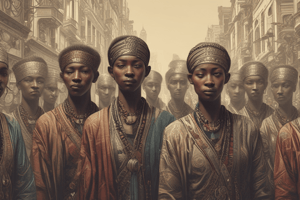Podcast
Questions and Answers
Define a group and explain the concept of mutual influence among its members.
Define a group and explain the concept of mutual influence among its members.
A group is a collection of three or more people who interact with one another and are interdependent in the sense that their needs and goals cause them to rely on one another. Mutual influence refers to the idea that members of a group can influence each other's thoughts, feelings, and behaviors.
What are some examples of groups?
What are some examples of groups?
Some examples of groups include family and friends, sports teams, university classes, and political or social justice/advocacy groups.
What is the fundamental need that motivates individuals to join groups?
What is the fundamental need that motivates individuals to join groups?
The fundamental need that motivates individuals to join groups is the need for social connection and interaction. It is intrinsically rewarding and has evolutionary reasons.
Why is it easier to achieve objectives collectively in a group?
Why is it easier to achieve objectives collectively in a group?
How do groups help individuals define themselves?
How do groups help individuals define themselves?
What are social norms and how do they influence behavior?
What are social norms and how do they influence behavior?
Give an example of a social role within a group.
Give an example of a social role within a group.
What are gender roles and how do they impact behavior?
What are gender roles and how do they impact behavior?
What is the Stanford Prison Experiment and why is it relevant to the study of social roles?
What is the Stanford Prison Experiment and why is it relevant to the study of social roles?
How can groups serve as frameworks to simplify the complex world?
How can groups serve as frameworks to simplify the complex world?
What is 'The Tragedy of the Commons'?
What is 'The Tragedy of the Commons'?
What is the Prisoner's Dilemma?
What is the Prisoner's Dilemma?
What are some strategies to increase cooperation in the Prisoner's Dilemma?
What are some strategies to increase cooperation in the Prisoner's Dilemma?
Is using threats an effective means of resolving conflict?
Is using threats an effective means of resolving conflict?
What is negotiation?
What is negotiation?
What is an integrative solution?
What is an integrative solution?
Why can it be difficult to identify what is most important to each side in a negotiation?
Why can it be difficult to identify what is most important to each side in a negotiation?
What is the main idea behind 'The Tragedy of the Commons'?
What is the main idea behind 'The Tragedy of the Commons'?
Why is consistent cooperation important in the Prisoner's Dilemma?
Why is consistent cooperation important in the Prisoner's Dilemma?
What is the tit-for-tat strategy in the Prisoner's Dilemma?
What is the tit-for-tat strategy in the Prisoner's Dilemma?
What is group cohesiveness and how does it influence problem-solving? Provide an example.
What is group cohesiveness and how does it influence problem-solving? Provide an example.
Explain the concept of group diversity and its impact on group performance.
Explain the concept of group diversity and its impact on group performance.
What is social facilitation and how does it affect task performance? Provide an example.
What is social facilitation and how does it affect task performance? Provide an example.
Explain the concept of social loafing and its impact on individual performance in groups. Provide an example.
Explain the concept of social loafing and its impact on individual performance in groups. Provide an example.
What is deindividuation and how does it contribute to impulsive and deviant behavior? Provide examples.
What is deindividuation and how does it contribute to impulsive and deviant behavior? Provide examples.
What is process loss in group decision-making? How does failure to share unique information contribute to process loss?
What is process loss in group decision-making? How does failure to share unique information contribute to process loss?
Define groupthink and explain how it can negatively impact decision-making.
Define groupthink and explain how it can negatively impact decision-making.
What is a social dilemma and why can it be challenging to find a solution? Provide an example.
What is a social dilemma and why can it be challenging to find a solution? Provide an example.
Explain the concept of conflict and cooperation within groups. How do they influence group dynamics?
Explain the concept of conflict and cooperation within groups. How do they influence group dynamics?
What is 'The Tragedy of the Commons' and how does it relate to social dilemmas? Provide an example.
What is 'The Tragedy of the Commons' and how does it relate to social dilemmas? Provide an example.




